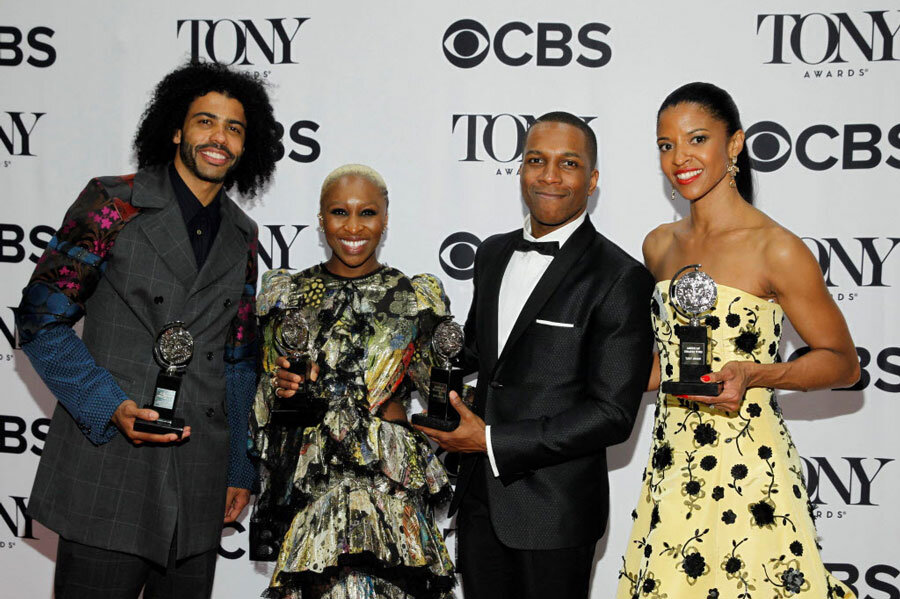History-making Tony Awards torn between sadness and celebration
In a Tony award show dedicated to the victims of the shootings in Orlando, the Broadway community defiantly celebrated Sunday night with undiminished brio.
“Your tragedy is our tragedy,” host James Corden said before the curtain went up on the 70th Tony Awards, speaking about the attack on a gay nightclub in Florida in which a shooter killed 49 people and injured 53. “Theater is a place where every race, creed, sexuality, and gender is equal, embraced, and loved. Hate will never win.”
The “Hamilton” juggernaut wrapped its march across the Broadway empyrean, winning 11 of its 16 nominations. But the dominance of the hip-hop historical musical only served to underscore the much-talked-about bigger winner in this year’s Tonys: diversity.
By the end of the night, the Tonys had made history by awarding all the musical acting prizes to actors of color. Leslie Odom, Jr., Daveed Diggs, and Renée Elise Goldsberry all won for “Hamilton,” while Cynthia Erivo, in a category packed with outstanding performers, won best actress for “The Color Purple.”
Indeed, the abundance of minority faces – more than a third of the nominees were people of color – was even more noteworthy in an entertainment season that was marked by the Academy Awards excluding minority actors from the nominations for the second year in a row, leading to the Oscars being raked over social media coals for being so monochromatic. The record nominations for “Hamilton,” for some social activists, stands in stark contrast to the shutout of minority filmmakers and performers from critically acclaimed films such as “Straight Outta Compton” and “Creed.”
Although the contrast was most certainly not intentional, says Earl Ofari Hutchinson, author of a dozen books on the black experience in America, “The first thing that came to my mind when I saw the Tony nominations was: If Broadway can do this, celebrate so many talented performers of color, why can’t Hollywood?”
But as the books close on what has turned into a record season driven by the once-in-a-generation phenomenon of “Hamilton” – which topped $1 billion in receipts according to Variety – the question remains of just how deep the sea change toward greater inclusiveness actually runs.
Both longtime Broadway observers and political activists suggest there is reason to be cautiously optimistic.
“Sometimes theater is a reflection of the past but because it’s all about storytelling, it also sets the tone for the future,” says Catherine Rodgers, head of the theater department at Meredith College in Raleigh, N.C. “As long as it’s telling the truth, cultural racial and gender diversity is what has to happen,” she says.
“Hamilton” and other nominated shows such as “The Color Purple” – another big winner of the night with a strong minority cast – and “Eclipsed,” which was written and directed by women of color and featured a female minority cast led by Oscar winner Lupita Nyong’o, are opening those doors and pointing the way for the larger culture, she says. The all-female creative team of “Waitress” also was a first for a nominated musical.
The strong roster of minority faces in the Tony nominations sends a powerful message to the rest of the entertainment industry, says Mr. Hutchinson, one that can’t be ignored. While the audience for Broadway shows may be small compared to those for film and television, he points out that this issue is not best measured in numbers but rather in influence.
“A lot of the American population may never see these plays, but the people who write the television shows and make the movies are paying close attention to what happens on Broadway,” he points out, adding that writers, performers and other talent are greatly influenced by the creative direction in live theater.
Besides the cross-fertilization process, Hutchinson points out that the two industries are different in important ways.
“Film and television have to hit and be successful right away, or they are canceled,” he points out. Plays and musicals on the other hand, gestate for years and benefit from extended rehearsal and development.
This fact was on vivid display during the Tony broadcast when President and Mrs. Obama came in via a recorded message. The president described welcoming Lin-Manuel Miranda, the creator of “Hamilton” to the White House some seven years ago when the show was in early development.
Mr. Miranda had one of the most emotional moments of the night, using his acceptance speech to read a sonnet he wrote in tribute to the victims of the Orlando attack. “We chase the melodies that seem to find us until they’re finished songs and start to play. When senseless acts of tragedy remind us that nothing here is promised, not one day,” he read. “And love, is love, is love, is love, is love, is love, is love, is love cannot be killed or swept aside...”
The shows that make their way to Broadway are a function of what producers and backers are willing to gamble audiences will pay to see, points out cultural historian Julian Chambliss, chair of the history department at Rollins College in Winter Park, Fla., who specializes in the minority experience.
“If something is successful on Broadway, it becomes a marker of a greater cultural paradigm shift,” he says. The narratives that make their way into this most elite crucible represent an important part of our cultural dialogue, he says. “We have a hip-hop play on Broadway, so does that mean hip-hop has broken through to cultural respectability?” Professor Chambliss asks.
The runaway popularity of the show means that on some level, this transformation of our cultural narratives to be more inclusive coincides with the growing racial profile of the country, which is heading toward becoming a majority minority society.
“It is the leading edge of broader cultural transformation,” says Chambliss adding, “we are becoming a blacker and browner country,” and these are the stories audiences will increasingly want to see.





